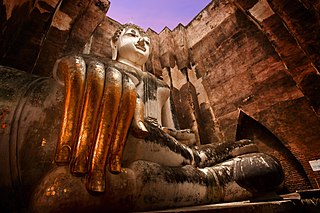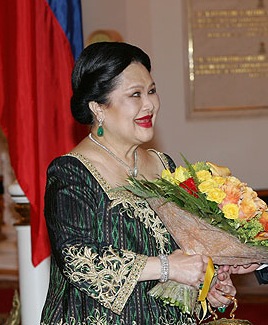
Sukhothai Historical Park covers the ruins of Sukhothai, literally 'dawn of happiness', capital of the Sukhothai Kingdom in the 13th and 14th centuries, in north central Thailand. It is near the city of Sukhothai, capital of Sukhothai Province.

Sirikit is a member of the Thai royal family who was Queen of Thailand from 28 April 1950 to 13 October 2016 as the wife of King Bhumibol Adulyadej. She is the mother of King Vajiralongkorn.

Phra Pathommachedi or Phra Pathom Chedi is a Buddhist stupa in Thailand. The stupa is located in the Wat Phra Pathommachedi Ratcha Wora Maha Wihan (Thai: วัดพระปฐมเจดีย์ราชวรมหาวิหาร), a temple in the town center of Nakhon Pathom, Nakhon Pathom Province, Thailand. Phra Pathommachedi is one of the tallest stupas in the world. The top of its spire reaches 120.45 meters, with the base circumference of 235.50 meters.

Wat Benchamabophit Dusitvanaram is a Buddhist temple (wat) in the Dusit District of Bangkok, Thailand. Also known as the Marble Temple, it is one of Bangkok's best-known temples and a major tourist attraction. It typifies Bangkok's ornate style of high gables, stepped-out roofs and elaborate finials.

Wat Chayamangkalaram, also known as the Chayamangkalaram Buddhist Temple, is a Theravada Buddhist temple within George Town in the Malaysian state of Penang. Situated at Lorong Burma opposite the Dhammikarama Burmese Temple, it is the oldest Siamese temple in the state. Wat Chayamangkalaram becomes a focal point for the annual Songkran, Loy Krathong and Vesak Day festivities within the city.

Somdet Kiaw was a Thai Buddhist monk who served as the abbot of Wat Saket and the acting Supreme Patriarch of Thailand.

Wat Bowaniwet Wihan Ratchaworawihan is a major Buddhist temple (wat) in Phra Nakhon district, Bangkok, Thailand. Being the residence of Nyanasamvara Suvaddhana, the late Supreme Patriarch of Thailand, it is the final resting place of two former kings of Chakri Dynasty: King Vajiravudh and King Bhumibol Adulyadej. The temple was established in 1824 by Mahasakti Pol Sep, viceroy during the reign of King Rama III.

Thai temple art and architecture is the art and architecture of Buddhist temples in Thailand. Temples are known as wats, from the Pāḷi vāṭa, meaning "enclosure". A temple has an enclosing wall that divides it from the secular world. Temples served as a stabilizing center in these communities because their sacred teachings became a basis of authority and boundaries, their precincts became places of instruction, their regimes of common ownership of property formed them into economic centers, and their functions allowed them to serve at the heart of these communities in a variety of ways.

Wat Phra That Phanom is a Buddhist temple in the That Phanom District in the south of Nakhon Phanom Province, all within the Isan region of Thailand near the Lao border. According to local legend, the temple contains in the pagoda the Phra Uranghathat (พระอุรังคธาตุ)/Phra Ura (พระอุระ)/Buddha's breast bones. As such, it is one of the most important structures for Theravada Buddhists and the most important Buddhist site in the province, with an annual week-long festival being held in the town of That Phanom to honour the temple. These festival attract thousands of people who make pilgrimages to the shrine. In Thai folk Buddhism, Wat Phra That Phanom is a popular pilgrimage destination for those born in the year of the Monkey.

Wat Phra Sri Rattana Mahathat (Thai: วัดพระศรีรัตนมหาธาตุ; "Temple of the Great Jewelled Reliquary"), colloquially referred to as Wat-Phra-Sri or Wat Yai (Thai: วัดใหญ่; "Big Temple"), is a Buddhist temple (wat) in Phitsanulok Province, Thailand, where it is located on east bank of Nan River, near Naresuan Bridge and opposite Phitsanulok Provincial Hall. It is about 337 km from Bangkok.
State decorations awarded by Thai King take the form of orders and medals. This page lists them by order of precedence.

A wat is a type of Buddhist and Hindu temple in Cambodia, Laos, East Shan State, Yunnan, the Southern Province of Sri Lanka, and Thailand.

Phra Mahathat Kaen Nakhon,(Thai: พระมหาธาตุแก่นนคร) Kaen Nakhon, 'The Great Buddha's Relics' or 'The Nine Story Stupa Located in Wat Nong Waeng,' is a Thai royal temple of the old town. Wat Nong Waeng is located close to Kaen Nakhon marsh on Klangmuang Road, Muang District. Phra Mahathat Kaen Nakhon was established to celebrate the Golden Jubilee Celebrations of His Majesty Bhumibol Adulyadej's accession to the throne and to celebrate the 200th anniversary of Khon Kaen province's establishment. Its thorough spire, Isaan fishnet shape, Indochina-Dvaravati Era Style, imitated Phra That Kham Kaen. Its base is a square shape of 50 meters on each side and 80 meters in height, where are situated the four-mini-Buddha's relics in each corner sheltered by a seven-head-nāga crystal wall.

According to the Mahāparinibbāṇa Sutta, after attaining parinirvana, the body of Buddha was cremated and the ashes divided among his lay followers.

Wat Prayurawongsawat Worawihan, known in short as Wat Prayun is a 19th century Buddhist temple complex, located near the Memorial Bridge in Bangkok, Thailand.

A Thai Buddha amulet, often referred to academically as a "votive tablet", is a type of Thai Buddhist blessed item. It is used to raise funds to help a temple's operations. A Thai Buddhist monk will give an amulet to Buddhists as a "gift" after they donate money or offerings to the temple. The amulets are then no longer considered a "gift" but a "tool" to enhance luck in different aspects of life. Local people also use amulets to improve their marriage, wealth, health, love, and relationships.

Somdet Phra Ariyavangsagatayana IX, born Amborn Prasatthapong, is the current Supreme Patriarch of Thailand and Superior General of the Dhammayut Order. Ordained as a bhikkhu in 1948 with the Dhamma name of Ambaro. In 2008 he was appointed abbot of Wat Ratchabophit in Bangkok. In 2017, he was appointed Supreme Patriarch by King Vajiralongkorn, succeeding Vajirañāṇasaṃvara who died in 2013.

Wat Ratchapradit Sathit Mahasimaram Ratcha Wora Maha Viharn is a Buddhist temple in the Phra Nakhon District of Bangkok. Wat Ratchaparadit was designated a first-class royal monastery in 1915, making it one of the most significant temples in Thailand.

Wat Sommanat Ratchaworawihan or known in short Wat Sommanat Wihan and Wat Sommanat is a second classed royal Thai Buddhist monastery was built in 1853 by the order of King Mongkut as a dedication and memorial to the Queen Consort Somanass Waddhanawathy, his first wife, who died at the age of 17.

Wat Yansangwararam Woramahawihan or Wat Yan is located in Huai Yai in the Chonburi province of Thailand. It is a large Buddhist temple complex with gardens and lakes and has been under the patronage of Bhumibol Adulyadej. Most of the buildings at Wat Yansangwararam were erected in honor of the Thai Royal Family. The temple is a replica of the Mahabodhi Temple in Bodh Gaya, Bihar, India.


























